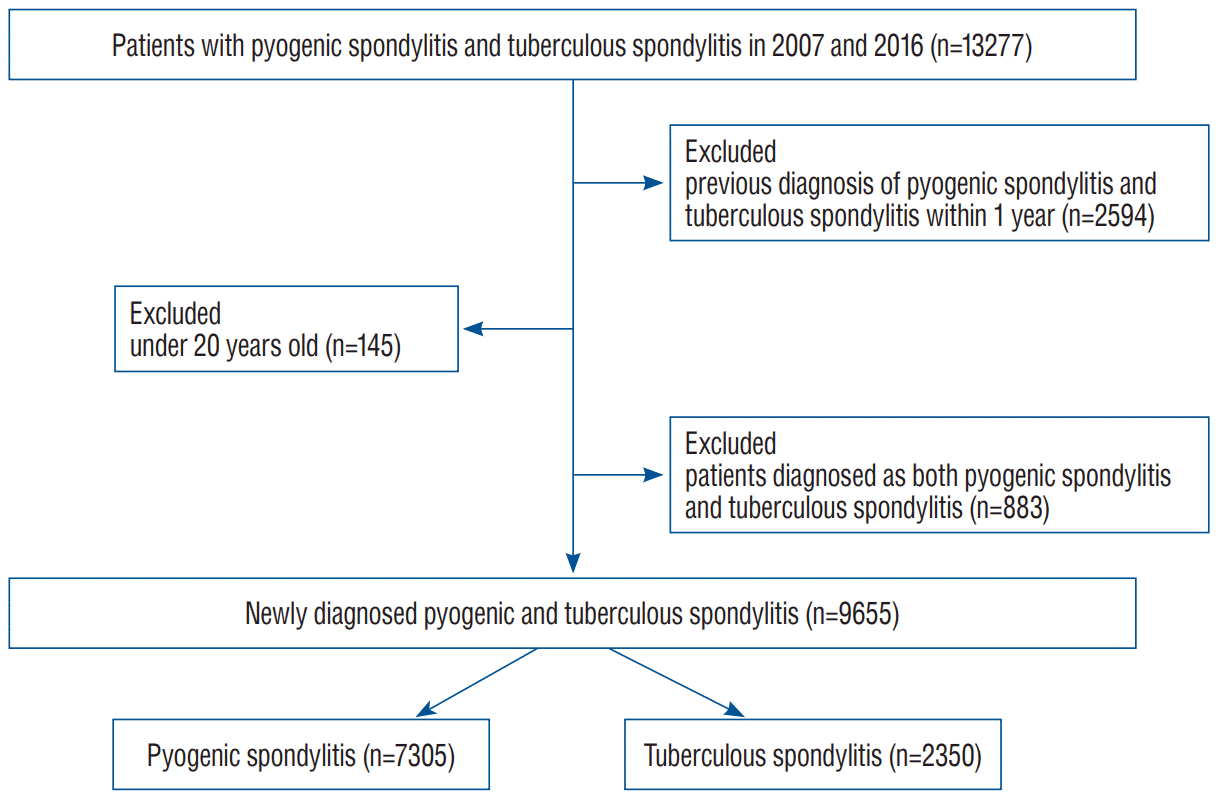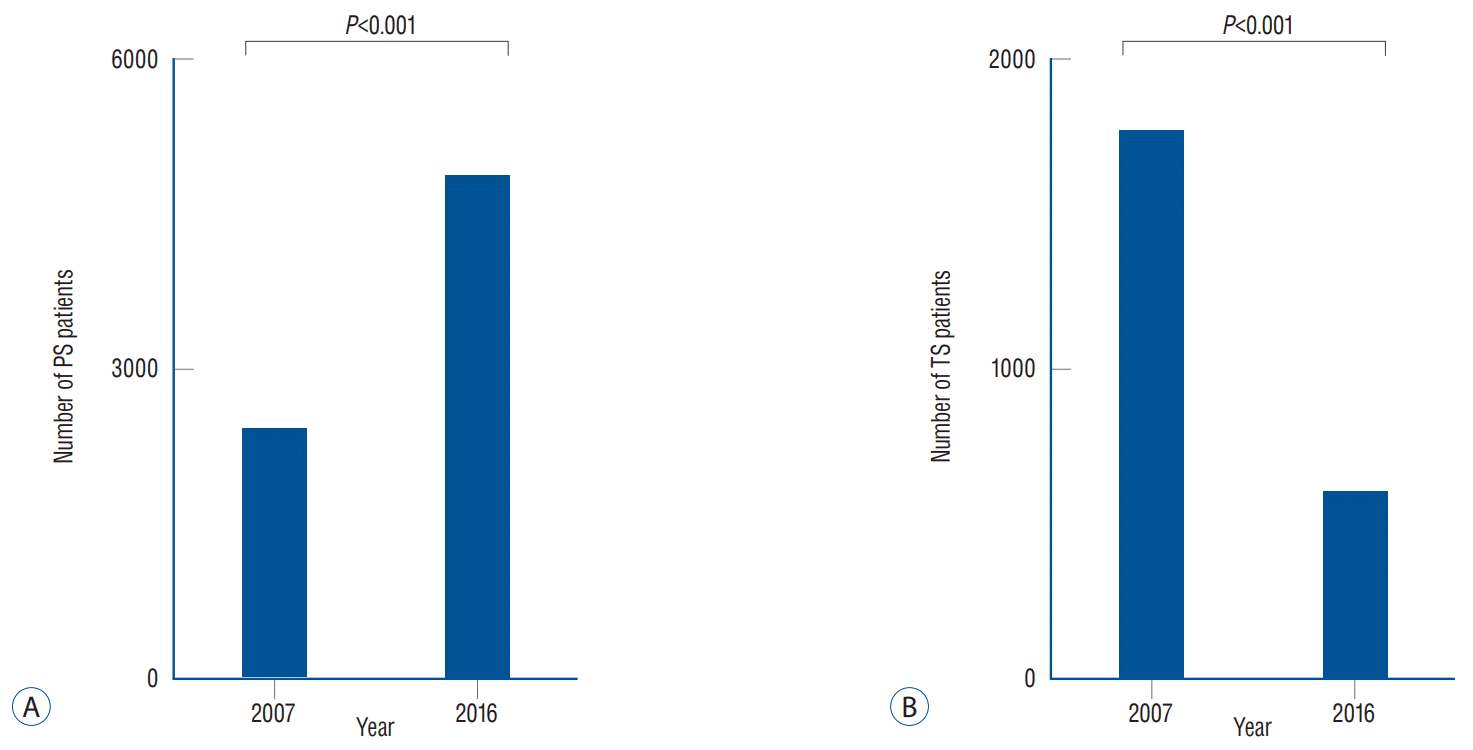1. Aagaard T, Roed C, Dragsted C, Skinhøj P. Microbiological and therapeutic challenges in infectious spondylodiscitis: a cohort study of 100 cases, 2006-2011. Scand J Infect Dis. 45:417–424. 2013.

2. Ahn JS, Lee JK. Diagnosis and treatment of tuberclous spondylitis and pyogenic spondylitis in atypical cases. Asian Spine J. 1:75–79. 2007.

3. Akiyama T, Chikuda H, Yasunaga H, Horiguchi H, Fushimi K, Saita K. Incidence and risk factors for mortality of vertebral osteomyelitis: a retrospective analysis using the Japanese diagnosis procedure combination database. BMJ Open. 3:e002412. 2013.

4. Cegielski JP, McMurray DN. The relationship between malnutrition and tuberculosis: evidence from studies in humans and experimental animals. Int J Tuberc Lung Dis. 8:286–298. 2004.
5. Cheung WY, Luk KD. Pyogenic spondylitis. Int Orthop. 36:397–404. 2012.

6. Colmenero JD, Jiménez-Mejías ME, Sánchez-Lora FJ, Reguera JM, Palomino-Nicás J, Martos F, et al. Pyogenic, tuberculous, and brucellar vertebral osteomyelitis: a descriptive and comparative study of 219 cases. Ann Rheum Dis. 56:709–715. 1997.

7. Cottle L, Riordan T. Infectious spondylodiscitis. J Infect. 56:401–412. 2008.

8. Fantoni M, Trecarichi EM, Rossi B, Mazzotta V, Di Giacomo G, Nasto LA, et al. Epidemiological and clinical features of pyogenic spondylodiscitis. Eur Rev Med Pharmacol Sci 16 Suppl. 2:2–7. 2012.
9. Forrester DM. Infectious spondylitis. Semin Ultrasound CT MR. 25:461–473. 2004.

10. Gouliouris T, Aliyu SH, Brown NM. Spondylodiscitis: update on diagnosis and management. J Antimicrob Chemother. 65 Suppl 3:iii11–iii24. 2010.

11. Grammatico L, Baron S, Rusch E, Lepage B, Surer N, Desenclos JC, et al. Epidemiology of vertebral osteomyelitis (VO) in France: analysis of hospital-discharge data 2002-2003. Epidemiol Infect. 136:653–660. 2008.

12. Guttmann OP, Rahman MS, O’Mahony C, Anastasakis A, Elliott PM. Atrial fibrillation and thromboembolism in patients with hypertrophic cardiomyopathy: systematic review. Heart. 100:465–472. 2014.

13. Jensen AG, Espersen F, Skinhøj P, Rosdahl VT, Frimodt-Møller N. Increasing frequency of vertebral osteomyelitis following Staphylococcus aureus bacteraemia in Denmark 1980-1990. J Infect. 34:113–118. 1997.

14. Jeong SJ, Choi SW, Youm JY, Kim HW, Ha HG, Yi JS. Microbiology and epidemiology of infectious spinal disease. J Korean Neurosurg Soc. 56:21–27. 2014.

15. Kehrer M, Pedersen C, Jensen TG, Lassen AT. Increasing incidence of pyogenic spondylodiscitis: a 14-year population-based study. J Infect. 68:313–320. 2014.

16. Kim CJ, Kim EJ, Song KH, Choe PG, Park WB, Bang JH, et al. Comparison of characteristics of culture-negative pyogenic spondylitis and tuberculous spondylitis: a retrospective study. BMC Infect Dis. 16:560. 2016.

17. Lee DH, Choi YJ, Han IB, Hong JB, Do Han K, Choi JM, et al. Association of ischemic stroke with ankylosing spondylitis: a nationwide longitudinal cohort study. Acta Neurochir (Wien). 160:949–955. 2018.

18. Lee DH, Choi YJ, Han IB, Hong JB, Do Han K, Choi JM, et al. Correction to: Association of ischemic stroke with ankylosing spondylitis: a nationwide longitudinal cohort study. Acta Neurochir (Wien). 160:957–958. 2018.

19. Lee KY. Comparison of pyogenic spondylitis and tuberculous spondylitis. Asian Spine J. 8:216–223. 2014.

20. Lora-Tamayo J, Euba G, Narváez JA, Murillo O, Verdaguer R, Sobrino B, et al. Changing trends in the epidemiology of pyogenic vertebral osteomyelitis: the impact of cases with no microbiologic diagnosis. Semin Arthritis Rheum. 41:247–255. 2011.

21. Noh SH, Zhang HY, Lee SH, Choi JK, Chin DK. Changes in trends of spondylitis in Korea based on a nationwide database. Yonsei Med J. 60:487–489. 2019.

22. Park CJ, Choi YJ, Kim JG, Han IB, Do Han K, Choi JM, et al. Association of acute myocardial infarction with ankylosing spondylitis: a nationwide longitudinal cohort study. J Clin Neurosci. 56:34–37. 2018.

23. Pigrau C, Almirante B, Flores X, Falco V, Rodríguez D, Gasser I, et al. Spontaneous pyogenic vertebral osteomyelitis and endocarditis: incidence, risk factors, and outcome. Am J Med. 118:1287. 2005.

24. Pigrau C, Rodríguez-Pardo D, Fernández-Hidalgo N, Moretó L, Pellise F, Larrosa MN, et al. Health care associated hematogenous pyogenic vertebral osteomyelitis: a severe and potentially preventable infectious disease. Medicine (Baltimore). 94:e365. 2015.
25. Skaf GS, Domloj NT, Fehlings MG, Bouclaous CH, Sabbagh AS, Kanafani ZA, et al. Pyogenic spondylodiscitis: an overview. J Infect Public Health. 3:5–16. 2010.

26. Sohn S, Chung CK, Han KD, Jung JH, Hyeun JH, Kim J, et al. A nationwide study of surgery in a newly diagnosed spine metastasis population. J Korean Neurosurg Soc. 62:46–52. 2019.

27. Sohn S, Chung CK, Jung JH, Lee KC, Kim J, Chang UK, et al. Nationwide comparative study of synchronous and metachronous spine metastasis in the adult Korean population. J Clin Neurosci. 57:33–37. 2018.

28. Sohn S, Kim J, Chung CK, Lee NR, Chang UK, Sohn MJ. A nationwide study of stereotactic radiosurgery in a newly diagnosed spine metastasis population. Stereotact Funct Neurosurg. 95:189–196. 2017.

29. Sohn S, Kim J, Chung CK, Lee NR, Park E, Chang UK, et al. A nationwide epidemiological study of newly diagnosed spine metastasis in the adult Korean population. Spine J. 16:937–945. 2016.

30. Sohn S, Kim J, Chung CK, Lee NR, Park E, Chang UK, et al. Nationwide epidemiology and healthcare utilization of spine tumor patients in the adult Korean population, 2009-2012. Neurooncol Pract. 2:93–100. 2015.

31. Sohn S, Kim J, Chung CK, Lee NR, Sohn MJ, Kim SH. A nation-wide epidemiological study of newly diagnosed primary spine tumor in the adult Korean population, 2009-2011. J Korean Neurosurg Soc. 60:195–204. 2017.

32. Torda AJ, Gottlieb T, Bradbury R. Pyogenic vertebral osteomyelitis: analysis of 20 cases and review. Clin Infect Dis. 20:320–328. 1995.

33. Waldvogel FA, Vasey H. Osteomyelitis: the past decade. N Engl J Med. 303:360–370. 1980.







 PDF
PDF Citation
Citation Print
Print



 XML Download
XML Download